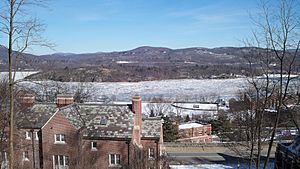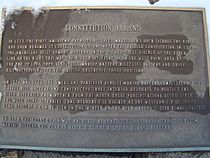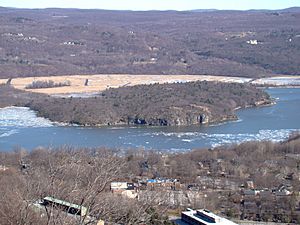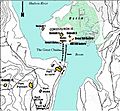Constitution Island facts for kids
Quick facts for kids Constitution Island |
|
|---|---|

Constitution Island from the west
at Merritt Road at West Point |
|
| Lua error in Module:Location_map at line 420: attempt to index field 'wikibase' (a nil value). | |
| Nearest city | West Point, New York, U.S. |
Constitution Island is a special place in New York, located on the east side of the Hudson River. It sits right across from the famous U.S. Military Academy at West Point. A marsh called Constitution Marsh connects the island to the eastern shore.
This island is the only part of the West Point military base that is on the east side of the Hudson River. Long ago, it was known as "Martelaer's Rock." Constitution Island played a very important role in the American Revolutionary War. It was home to some of the first forts built in the Hudson Valley to protect the area.
British forces briefly captured the island in 1777. However, American soldiers took it back in 1778. It then became a key part of "Fortress West Point." The island was given to the military academy in 1909. Since then, the West Point Museum has taken care of it.
A new Education Center was finished in 2016. The historic Warner House has also been fully restored and has been open as a museum since the spring of 2020.
Contents
What's in a Name? Martelaer's Rock
Between the towns of Cold Spring and West Point, there is a large, rocky island. It connects to the eastern shore by a marshy area. Early Dutch sailors called this island "Martelaer's Island." They named the part of the river near it "Martelaer's Rack," or "Martyr's Reach."
The word "martyr" here meant "struggling." This was because ships sailing up the river often faced strong winds. They would struggle against the wind right after passing the island.
Fort Constitution: Protecting the Hudson River
Both the Americans and the British knew how important the Hudson River was during the Revolutionary War. It was a main route for moving supplies and soldiers. So, controlling the river was a big deal.
On May 25, 1775, the American leaders decided to build forts in the Hudson highlands. These forts would protect the river and keep it under American control. General George Washington worked with New York leaders to plan these defenses.
Local scouts chose Martlaer's Island as the first spot. It was perfect because of a strategic curve in the river. An engineer named Bernard Romans started building a large fort there. It was named "Fort Constitution."

The plans for Fort Constitution included four strong defense points called bastions. Construction began in the summer of 1775. Soon, the island became known as Constitution Island. By November, it had 70 cannons ready for battle.
However, building the fort was difficult and expensive. Because of these problems, the project was stopped. Instead, efforts moved to a new site further south. The unfinished Fort Constitution was later destroyed by British troops in 1777.
In 1778, a Polish engineer named Thaddeus Kosciusko designed "Fortress West Point." This was a system of forts and small defense posts on both sides of the river. On Constitution Island, soldiers built barracks, three new defense posts, and a water battery.
The Great Chain: A River Barrier
The island is famous for being the eastern anchor point of the Great Chain. This was a huge iron chain that stretched across the narrow part of the Hudson River. It went from Constitution Island to the mainland at West Point.
The chain's purpose was to stop British warships from sailing freely up the Hudson River. This was the second time Americans tried to block the river with a chain. The first chain failed when the British attacked Forts Montgomery and Clinton.
The Great Chain stayed in place from 1778 to 1782. It was removed only during winter months when ice blocked the river. After the war, Constitution Island returned to civilian use.
Tadeusz Kościuszko and Thomas Machin helped design a special winding machine called a capstan. This machine was used to pull the chain in and out of the water. Kosciuszko also added two batteries, the Lanthorn Battery and the Knox Battery, to protect the area.
The first chain had links that were one and a half inches thick. In 1778, it was replaced with a stronger chain. Its links were two and a quarter inches thick, two feet long, and weighed 140 pounds each! This massive chain was 1500 feet long and weighed 186 tons. It floated on huge logs, and forty men were needed to remove it each winter.
The Warner House and Its Legacy
The Warner House is a historic building on Constitution Island. It is part of the United States Military Academy's National Historic Landmark. The West Point Museum manages the house.
The Warner family owned the island and lived in the house from 1838 to 1915. Two sisters, Susan Bogert Warner and Anna Bartlett Warner, were very popular writers. Their books sold millions of copies in the United States, England, and other countries. They are known as important American women writers of the 1800s. Anna Bartlett Warner also wrote the famous song "Jesus Loves Me."
In 1908, Anna Warner sold the island to Mrs. Olivia Sage. Mrs. Sage was the widow of a wealthy businessman. Later that year, Mrs. Russell Sage and Miss Anna Warner gave Constitution Island to the United States government. They had some important rules for the gift.
They stated that the island should always be for the use of the U.S. Military Academy at West Point. They also said that no part of it should ever be used as a public picnic or amusement park run for profit.
President Theodore Roosevelt thanked them for their generous and patriotic gift. Both sisters are buried at West Point Cemetery.
The Constitution Island Association is a group that helps visitors learn about the island's history. They also maintain the beautiful gardens around the Warner House. The Military Academy has made many improvements to the island. These include better roads, drainage, and walking trails. The West Point Museum and the U.S. Army Garrison built the Education Center on the island. This project was a team effort and was funded by the United States Army Garrison, West Point.
Images for kids
See also
- Fort Putnam
- Fort Clinton (West Point)
- Redoubt Four (West Point)
- Kosciuszko's Garden
















